Sewage Water Treatment Vat: Difference between revisions
| Line 75: | Line 75: | ||
[[Cryptosporidium]] is another waterborne pathogenic bacterium found in wastewater. Several methods were developed to recover [[Cryptosporidium]] from sewage water. After recovery the pathogen was tested for infectivity. [14] [[Cryptosporidium]] causes cryptosporidiosis which is acquired through tainted drinking water. Some symptoms of this disease include: watery diarrhea, nausea, vomiting, fever, and malaise. [3] No specific treatments are known for this disease; however certain antibiotics can be effective for treatment. [[Cryptosporidium]] is removed from sewage water by dissolved-air floatation or by dual-media filtration. [15] | [[Cryptosporidium]] is another waterborne pathogenic bacterium found in wastewater. Several methods were developed to recover [[Cryptosporidium]] from sewage water. After recovery the pathogen was tested for infectivity. [14] [[Cryptosporidium]] causes cryptosporidiosis which is acquired through tainted drinking water. Some symptoms of this disease include: watery diarrhea, nausea, vomiting, fever, and malaise. [3] No specific treatments are known for this disease; however certain antibiotics can be effective for treatment. [[Cryptosporidium]] is removed from sewage water by dissolved-air floatation or by dual-media filtration. [15] | ||
[[Image:Cryptococcosis.jpg|thumb|left| | |||
Cryptosporidium viewed with a microscope in intestinal cells. http://origin.cdc.gov/healthypets/images/diseases/cryptococcosis.jpg | |||
===Virus=== | ===Virus=== | ||
Revision as of 05:30, 30 August 2008
Introduction
Sewage is deemed to be any form of both liquid and solid waste, equally produced by humans and animals; of these are: fecal matter, a kaleidoscope of garbage, un-reclaimed water and any other byproducts of which trek mainly through sewers and drainage systems. Sewage also includes larger materials such as: rags, cans, bottles, twigs, gravel, tampons, condoms, sand, and glass. [1 and 2] It is the main source of pollutants in water around the world. Water pollution is the disruption of physical, biological, and chemical conditions of the ecosystem. Accumulation of pollutants in the water is a result of waste which has not been destroyed faster than produced. Oxygen-demanding substances, organic matter and ammonia are examples in brevity of the numerous, however, different types of pollutants which accumulate in sewage. Further, sewage contains microorganisms such as: bacteria, protozoa, fungi, and viruses. Nutrients available to microorganisms, including: carbon, nitrogen and phosphorous can also be found in sewage. [3]
There is a wide variety of diverse microbes that inhabit this niche. Microbial diversity was founded based upon 16S ribosomal ribonucleic acid gene library analyses. [3] Microbes are either beneficial or harmful to the environment. Both organic molecule and nitrogen removal are forms of beneficiary advantages bacteria provide during sewage treatment. Harmful bacteria have the ability to cause infections as well as disease not only to people but also matter in which it can plague. Estimates from the Environmental Protection Agency report that an approximate 30 million of Americans develop a gastrointestinal illness. Furthermore, the Center for Disease Control report about 900 to 1000 people die annually from microbial illnesses. Such illnesses are considered to be caused by waterborne bacterium. It is necessary that wastewater be reclaimed and free of pollutants, so as to be to be safely consumed. Sewage water treatment plants filter wastewater through several steps known as pre-treatment, primary treatment, secondary treatment, and tertiary (advanced) treatment. [1 and 2]
Steps to Sewage (wastewater) Treatment
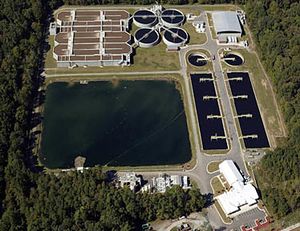
Pretreatment
Treatment of sewage water begins with Pretreatment, comprised of two parts. First is a coarse screening, which removes large materials including: rags, logs, bottles, and cans. Mechanical devices with cutting bars called comminutor, may also be used to cut and shred solids. Following, the water passes through what is known as the grit chamber where sand, cinder, broken glass, and other pebbles are removed. This step is crucial due to the fact that large materials could possibly cause operating problems by clogging aeration devices and forcible wear of treatment pumps leading to imprecise management of the sewage water. [2]
Primary Treatment
With the completion of screening for solids and removing grits, wastewater further contains dissolved organic and inorganic solids, which will be treated in the course of its’ Primary Treatment. These particles are removed by gravity in a sedimentation tank, which gravitate to the bottom of the tank, forming a mass of solid called sludge. The sludge is then usually removed by mechanical equipment. [2]
Secondary Treatment
Following primary treatment, the wastewater progresses to the next phase called Secondary Treatment. Here, up to 90 percent of the organic matter is removed using biological treatment processes. Secondary Treatment entails two methods: may be trickling filters or activated sludge and then disinfecting, known as secondary clarification. [1 and 2]
The first step consists of the trickling filter, which is a bed of coarse stone or perforated plastic material over which wastewater is sprayed. Microbial growth occurs on the stone or plastic surfaces and as wastewater is sprayed onto the filter, oxygen is then selected and passed to the microbes. With high concentrations of oxygen, these microbes are able to break down organic molecules within the wastewater. The wastewaters then precede the trickling filters and enter secondary clarifiers, where the microorganisms typically settle out. [2]
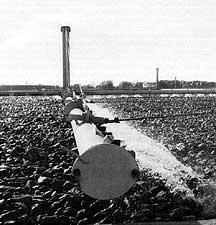
Activated sludge is another method for wastewater treatment in the secondary treatment process. Wastewater, containing organic material is mixed with microbes, which then are aerated. When the microbes feed on the organic molecules, they grow and tend to flocculate to form a mass of microbes called activated sludge. The wastewater flows into aeration tanks and mix air with the activated sludge to provide oxygen for the microbes and break down organic pollutants. This mixture is known as mixed liquor. The mixed liquor then flows to the secondary clarifiers and settles out for disinfection. Some of the settled sludge is returned back to the aeration tank to break down more organic pollutants. [2]
Next, disinfecting processes are utilized to destroy different microorganisms including bacteria and viruses. Ultraviolet radiation, chlorine, and ozone are three ways of which wastewater is disinfected. Ultraviolet radiation kills bacteria by damaging its genetic material. Though useful as a disinfectant, it requires higher dosages of radiation. At lower levels of radiation, endospores of bacterium are able to survive. The use of chlorine is a better method of killing bacteria, in doing so destroying genetic matter. However, the use of chlorine has been shown to be less effective on viruses. On the other hand, Ozone is a superior method in helping to destroy viruses. It is beneficial to the environment due to the fact that it decomposes to oxygen rapidly without leaving harmful byproducts. [1]
Tertiary (advanced) Treatment
Although Secondary Treatment destroys most of bacteria and viruses; other pollutants, such as: nitrogen, phosphorus, solids, and some organic materials may still be left over within the wastewater. Tertiary Treatment, also known as Advanced Treatment, is used to remove these remaining pollutants. [1]
Nitrogen is removed from the wastewater to control the growth of algae. In addition, nitrogen in the form of ammonia exerts an oxygen demand and can be toxic to aquatic life. Nitrogen is removed biologically through two processes known as nitrification, where ammonia is oxidized to nitrate and denitrification, wherein nitrate is converted to nitrogen gas and is released into the atmosphere. [1 and 2]
Like nitrogen, phosphorus is a nutrient which makes the growth of algae possible. Chemicals including: ferric chloride, alum, or lime are added to the wastewater, which allow the smaller particles including phosphorus to group into larger masses which then are removed through the sedimentation tanks. [1 and 2]
Heavier solids are removed by a process called chemical coagulation-sedimentation, wherein specific chemicals create solids which become denser than water allowing the solids to settle on the surface. [1]
Lastly, some organic materials from the wastewater which resisted removal by biological treatment are sequestered by carbon adsorption. In doing so, the wastewater passes through a bed of activated carbon granules, removing 98 percent of the organic material. [1]
Microorganisms
Microorganisms are present in sewage water treatment vats well throughout the entire process. [2] Microorganisms encompassing: bacteria, protozoa, and viruses, in the treatment vats, exist and grow in the sewage water and are transferred throughout the vats with the movement of sewage water. [3] Some microorganisms are used during the secondary treatment to remove pollutants. However, most microorganisms will be removed from the wastewater during the disinfection stage of the treatment. There are some microorganisms that continue on to the tertiary treatment to utilize removal of other pollutants like nitrogen, but will later be disinfected and killed. [1, 2, and 3]
Bacteria
Wastewater treatment vats are inhabited by varied and broad strains of bacteria. Bacteria cause countless human, animal and plant diseases by infecting their cellular host(s) through ingestion of contaminated food or water, through the fecal-oral route. Human pathogens can be caused by zoonosis, non-human hosts, which include bacteria capable of causing waterborne diseases. Bacteria of such capabilities include but are not limited to: Escherichia coli O157:H7, Vibrio cholerae, and Helicobacter pylori. Such bacteria are present right from the start of the treatment vats due to their arrival with sewage water. [3]
Furthermore, biofilm forming bacteria are present in the trickling filter phase of the secondary treatment process, considered to be beneficial in the removal of organic materials. Of these include: Pseudomonas, Zooglea, Chromobacter, and Flavobacterium, namely a few of whom are aerobic heterotrophic organisms. Such bacteria are exposed to oxygen during the treatment to break down the organic molecules. There are nitrogen removing bacteria known as nitrifiers and denitrifiers. Nitrifiers include strains Nitrosomonas europaea as well as Nitrobacter hamburgensis. Denitrifiers include strains Thiobacillus denitrificans. Moreover, traces of Gram-negative bacteria can also be found in the wastewater treatment vats, such as Bdellovibrio bacteriovorus, which penetrate and lyses other gram-negative bacteria within sewage water. Lastly, there are also sulfate reducing bacteria which such as Desulfotomaculum and Desulfovibrio, whom reduce sulfate. These sulfate reducing microbes prefer environments with an approximate pH 7 and are inhibited below pH value of 5.5 and above 9. Optimum temperature ranges between 28 and 32 degrees Celsius. [3]
Harmful Bacteria
Strains of Escherichia coli are part of a coliform group of bacteria found in sewage treatment vats. Due to the fact that it is a facultative bacterium consisting of Gram-negative rods, the bacterium can be found either on the surface or the bottom of water. E. coli contains a pH value of 7.75 and anything more than one unit above or below is considered stressful to its’ environmental optimum growth factor. Contact with some harmful strains of Escherichia coli such as serotype O157:H7 can result in food poisoning and diarrhea.
E. coli is used as a fecal indicator because it is unable to survive for long outside enteric walls. Waste excretions from boaters can perpetuate the additional pollution to water. Ultraviolet radiation, chlorination, and ozonation are ways of removing strains and serotypes of Escherichia coli from the sewage water. [3]

Vibrio cholerae (Vibrio cholerae 01) is another bacterium which dwell in wastewater treatment vats. This pathogenic bacterium was first discovered in Peru. It contains a pH value of 6.3 - 6.7 within sewage treatment vats. Vibrio cholerae enters sewage through excretion of fecal matter, either by humans or animals. Vibrio cholerae lives in the gastrointestinal tract which causes cholera and several other diseases caused by ingestion of contaminated water. Such bacteria produce exotoxins which interfere with intestinal water balance, which is then destroyed by heating. Vibrio cholerae]] is eradicated from wastewater by chlorine or high doses of UV radiation. [3]
Beneficial Bacteria
Bdellovibrio bacteriovorus is a gram-negative, obligate aerobic, parasitic bacterium that penetrates other gram-negative bacteria. [11] Bdellovibrio are ubiquitous in nature, surviving in mammalian intestines, aquatic and terrestrial habitats and in sewage treatment vats. During examination, this predatory organism was found in all of the different wastewater treatment steps. This organism is able to replicate on the aerobic filter film but is unable to live in anaerobic sludge. The main function of this bacterium is to purify waste water by reducing gram-negative bacteria with the ability to survive within sewage. The parasite is able to penetrate a host, replicate, and finally lyses the hosts’ cells. The organism sticks to the host’s outer membrane and releases enzymes which break down the cell wall. Afterwards, it perforates into the periplasm and repairs the cell wall. Following, it releases hydrolytic enzymes into the cytoplasm which amplify essential nutrients necessary for bacterial growth. Once the food supply decimates, Bdellovibrio bacteriovorus begins to differentiate. As a result, the host cell lyses releasing the newly multiplied cells into the environment. These newly released bacteria travel and find new bacteria to invade. [11 and 12]
Brocadia anammoxidans are anaerobic bacteria and is one of several oxidizers of ammonia. This bacterium was initially found in yeast and later in the 1990’s, within the ocean. It was later discovered in the Netherlands in a sewage water treatment plant. It can be a cost-efficient and proven method of treating wastewater. One other beneficial factor [[Brocadia anammoxidans is its’ ability to take in ammonia from the sewage water, by the release hydrazine (rocket fuel) via an enzyme called hydroxylamine oxidoreductase. Hydrazine is stored in a particular organelle to later bind with a fatty-acid membrane. The bacterium cannot make enough fuel for NASA to launch a rocket, however, it can be a practical method of clarifying wastewater of forms of ammonia. [13]
Nitrogen removal from wastewater is carried out through the: oxidation of ammonia to nitrite, the oxidation of nitrite to nitrate, and finally, the conversion of nitrate to nitrogen gas. There are several other bacteria, in addition to Brocadia anammoxidans, used during nitrification and denitrification processes. These organisms include but are not limited to: Nitrosomonas europaea, Nitrobacter hamburgensis, and Thiobacillus denitrificans.
Nitrosomonas europaea is an ammonia-oxidizing bacterium who plays an important role in sewage water treatment. This microbe catalyzes the foremost phase in the oxidation of toxic ammonia to nitrite. N. europaea is an aerobic, gram negative chemolithotroph that lives in polluted places with high levels of nitrogen compounds, in this case especially sewage water. Its’ optimum temperature ranges between 20 to 30 degrees Celsius and pH levels between 6.0 and 9.0. This microorganism derives energy from burning ammonia together with oxygen, and then utilizes such dynamic to further proliferate. [4 and 5]
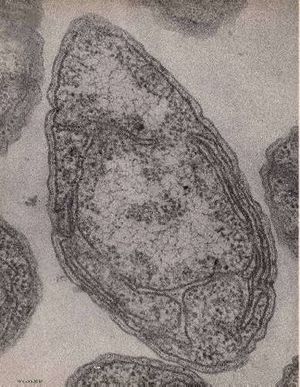
Nitrobacter hamburgensis is a gram negative, obligate chemolithotroph which exhibit an aerobic lifestyle, dependent on oxygen. Nitrobacter hamburgensis is a nitrifying organism and is vital during the process of sewage water treatment due to the fact that it is capable of catalyzing the oxidation of nitrite to nitrate, the second phase of nitrification. [4 and 6]
Thiobacillus denitrificans are implicated for the duration of the third phase of the nitrogen removal cycle. This organism denitrifies nitrate to nitrogen gas, which is then released into the atmosphere. T. denitrificans use inorganic sulfur compounds as an energy source. Their optimal conditions vary between 30 degrees Celsius and pH levels ranging between 7.5 and 8.0. [7]
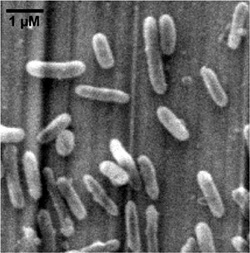
Protozoa
Several types of protozoa such as: amoebae, ciliates, and flagellates are found present throughout the entire sewage water treatment process. The importance of protozoa in wastewater treatment is to maintain a slime layer within trickling filter systems. They play a predatory role in removing bacteria, other protozoa, and several small particles. Protozoa have multiple feeding mechanisms: of these are filter and raptorial feeding. Filter feeders consume during the trickling filter phase when water is passed through the filter. Raptorial feeders, such as flagellates and amoebae, feed on different types of bacteria. Larger forms of amoebae eat ciliates and flagellates as well as smaller amoebae feed primarily on bacteria, exemplar of a latter mode of consumption. While protozoa are useful in wastewater treatment, they too, can be detrimental to humans if ingested. Protozoan parasites like Giardia lamblia and Cryptosporidum, which occupy parts of the gastrointestinal tract; can contribute to human morbidity and mortality. [3]
Giardia lamblia is a waterborne pathogen found in sewage water. G. lamblia enters the water supply through contamination by fecal matter. It is a protozoan parasite located in the small intestines. Giardia lamblia causes giardiasis, more commonly known as backpacker’s diarrhea. Cysts formed by the protozoan can be ingested by drinking contaminated water. As the cyst enters the stomach, the parasite is released into the gastrointestinal tract, adhering to the intestinal wall, and ultimately reaching the large intestine. In the large intestine, the pathogen will encyst once more and eventually be excreted back into the water. [3]
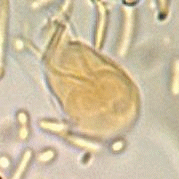
Cryptosporidium is another waterborne pathogenic bacterium found in wastewater. Several methods were developed to recover Cryptosporidium from sewage water. After recovery the pathogen was tested for infectivity. [14] Cryptosporidium causes cryptosporidiosis which is acquired through tainted drinking water. Some symptoms of this disease include: watery diarrhea, nausea, vomiting, fever, and malaise. [3] No specific treatments are known for this disease; however certain antibiotics can be effective for treatment. Cryptosporidium is removed from sewage water by dissolved-air floatation or by dual-media filtration. [15]
[[Image:Cryptococcosis.jpg|thumb|left|
Cryptosporidium viewed with a microscope in intestinal cells. http://origin.cdc.gov/healthypets/images/diseases/cryptococcosis.jpg
Virus
Enterovirus and rotavirus, amongst a handful of viruses are excellent indicators of human fecal contamination in wastewater evident through their attributes and association with human infections. Said viruses can also be found throughout the process of sewage water treatment. Samples taken for examination, from the wastewater by these viruses must be maintained at temperatures below 10 degrees Celsius and a pH between 3.5 and 4. Such viruses are beneficial in indicating fecal contamination in wastewater, though at the same rate can be detrimental to humans, if consumed. Enteroviruses and rotaviruses are detected in wastewater using living cells as hosts due to the fact that viruses are obligate intracellular parasites which need living cells to be able to replicate. Life threatening diseases, such as Polio and Hepatitis A, are caused by enteroviruses. Furthermore, life threatening forms of diarrhea are caused by rotaviruses. Viruses are removed from water through ozonation, a process of disinfection. [3]
Two enteroviruses present in sewage water treatment involve Hepatitis A and Polio myelitis. Hepatitis A contributes to one of the most widespread infections transmitted by trough the fecal-oral route. Some symptoms of Hepatitis A include: flu-like symptoms, nausea, vomiting, diarrhea, bulimia, jaundice and abdominal pain. There are no, known treatments, however there are vaccinations available for prevention. Polio myelitis is another virus which dwells within the waste water niche. Polio is a contagious disease caused by the ingestion of contaminated water, entering through the fecal-oral route. The majority of those infected with the virus acquire asymptomatic polio and the minority develops both abortive, non-paralytic and paralytic polio. [3]
Current Research
Occurrence of Ammonia-Oxidizing Archaea in Wastewater Treatment Plant Bioreactors
It has been found that autotrophic oxidation of ammonia is not only restricted to bacteria within wastewater treatment plant bioreactors. Molecular evidence confirm that ammonia-oxidizing archaea (AOA) may be present in activated sludge bioreactors and help with the removal of ammonia. This AOA is known Nitrosopumilus maritimus and grows chemolithoautotrophically by oxidizing ammonia to nitrite. N. maritimus is found to contain the genes for subunits, amoA, amoB, and amoC, of ammonia monooxygenase, which is the key enzyme for bacterial ammonia oxidation. Polymerase Chain Reaction (PCR) primers are used to target archaeal amoA gene to rapidly, specfically find gene sequences in activated sludge bioreactors. [8]
Samples were collected from nine bioreactors where nitrification was found to be active. 75 archaeal amoA sequences were retrieved, but only from five of the bioreactors due to the fact that there were no sequences detected in the other four. These sequences were operating on extremely low dissolved oxygen concentrations and long retention times. Phylogenic analysis showed that all the archaeal amoA sequences retrieved from the activated sludge samples are closely related to the sequences found in sediments and soil. These sequences are grouped into four clusters, known as clusters A, B, C, and D. Cluster D includes almost identical, about 98 to 100 percentage of nucleotide identity, clones from all five activated sludge samples. In addition, accounts for 67 percent of all amoA sequences found, evidently proving that AOA from cluster D may be widespread in activated sludge bioreactors at wastewater treatment plants. [8]
Transfer of Class 1 Integron-Mediated Antibiotic Resistance Genes from Shiga Toxin-Producing Escherichia coli to a Susceptible E. coli K-12 Strain in Storm Water and Bovine Feces
Excess use of antibiotics in agricultural environments is presumed to be the cause of antibiotic resistance genes among bacteria and is swiftly becoming a threat to human and veterinary medicine. Resistance genes which are linked to integrons are transferred by conjugative plasmids to homologous and heterologous bacteria. The goal of this research is to further discover if the transmission of integron-mediated antibiotic resistance genes from STEC to generic E. coli can occur in storm water and bovine feces, and if temperature and pH can increase the transfer of the antibiotic resistance gene. Samples and materials such as bacterial strains, environmental samples, storm water, and bovine feces were separately collected. Bacterial strains and environmental samples were used from labs and Class 1 integrons responsible for the resistance were isolated. Storm water was accumulated from Griffin, Georgia and stored in a glass. Bovine feces were acquired from a cattle farm in Griffin. Donor and recipient cells were put in a tryptic soy broth at 37 degrees for 16 hours followed by centrifugation for 15 minutes. Conjugation of storm water and bovine feces were done utilizing a similar method. Analysis of transconjugants showed that resistance to tetracycline and oxytetracyline were co- transferred with a resistance to streptomycin by Class 1 integron. [9]
Influence by temperature showed that antibiotic resistant came mainly from storm water and bovine feces at 28 degrees Celsius. Influence by pH showed that gene transfer was conducted in bovine feces and storm water at near-neutral pH. All together the researchers discovered that the transfer of Class 1 integron antibiotic resistant gene was transferred to E. coli in a lab from bovine feces and storm water. [9]
Rapid Ultrafiltration Concentration and Biosensor Detection of Enterococci from Large Volumes of Florida Recreational Water
A contaminant indicator, such as Escherichia coli and Enterococcus (spp), demonstrates the concentration of fecal matter in the water. Enterococcus was used to find out fecal contamination in recreational waters located in Florida through filtration. The research’s goal was to discover new methods of immediately identifying fecal matter in recreational coastal waters as well as a means of public health protection. Methods devised included: antibodies, bacteria, ELISA, raptor instrument and waveguide preparation, indirect raptor assay with cells in buffer, hollow-fiber concentration systems, post-filtration, membrane filtration, and indirect raptor assay with concentrated samples. [10]
A water sample of 100-liter was gathered from upper Tampa Bay within a 9-month period. Ultrafiltration (UF), membrane filtration samples were gathered on site. Postfiltration processes’ including sonication was utilized to eradicate disruptive particles. The new method of ultrafiltration-biosensor procedure requires 2.5 hours for detection, as apposed to 24 hours with the older method. Through the research conducted, it is indicative and evident that prompt discovery of Enterococci through: ultrafiltration, secondary concentration, and biosensor analysis, can be advantageous in ascertaining possible contaminants within recreational water. [10]
Summary
Sewage, in all forms, consists of byproducts produced as well as consumed by animals and humans; of these include the following though are not reserved to: plastic, glass, soil, un-reclaimed water from storms, along with excrements. Microorganisms among bacteria, protozoa, and viruses dwell within this niche. Treatment of sewage water consists of four stages: pre-treatment, primary treatment, secondary treatment, and tertiary (advanced) treatment. Microorganisms, which vary, are present throughout the entire treatment process. Though most microbes in wastewater are reckoned as harmful to aquatic life and humans, there are several other types of microbes which can be advantageous in the removal of pollutants and consequential microbes from the waste water. Through the clarification of wastewater, in due course, all noxious microorganisms are sequestered along with other pollutants. Ultimately, clarified wastewater is released into streams with the possibility of being used as efficacious drinking water.
Reference
1. [United States Environmental Protection Agency. Primer for Municipal Wastewater Treatment Systems. 2004.]
2. [City of Battle Creek, Michigan. Steps in Wastewater Treatment. 2005.]
3. [Duncan Mara and Nigel Horan. The Handbook of Water and Wastewater Microbiology. 2003.]
4. [Michael Wagner and Alexander Loy. Bacterial Community Composition and Function in Sewage Treatment Systems. Current Opinion in Biotechnology. 2002. Volume 13. Issue 3. Pages 218-227.]
5. [The Regents of the University of California. Doe Joint Genome Institute. Nitrosomonas europaea ATCC 19718. 2001-2008.]
6. [Dennis Kunkel Microscopy, Inc. Scientific Stock Photography. Image 23858B.]
7. [Gunter Claus and Hans Jurgen Kutzner. Physiology and Kinetics of Autotrophic Denitrification by Thiobacillus denitrificans. Applied Microbiology and Biotechnology. 1985. Volume 22, Pages 283-288.]
8. [Hee-Deung Park, George F. Wells, Hyokwan Bae, Craig S. Criddle, and Christopher A. Francis. Occurrence of Ammonia-Oxidizing Archaea in Wastewater Treatment Plant Bioreactors. Applied and Environmental Microbiology. (2006). Volume 72. No. 8. Pages 5643-5647.]
9. [Supakana Nagachinta and Jinru Chen. Transfer of Class 1 Integron-Mediated Antibiotic Resistance Genes from Shiga Toxin-Producing Escherichia coli to a Susceptible E. coli K-12 Strain in Storm Water and Bovine Feces. Applied and Environmental Microbiology. 2008. Volume 74. No. 16. Pages 5063-5067.]
10. [Stephaney D. Leskinen and Daniel V. Lim. Rapid Ultrafiltration Concentration and Biosensor Detection of Enterococci from Large Volumes of Florida Recreational Water. Applied and Environmental Microbiology. 2008. Volume 74. No. 15. Pages 4792-4798.]
11. [Dominik Schwudke, Michael Linscheid, Eckhard Strauch, Bernd Appel, Ulrich Zähringer, Hermann Moll, Mareike Müller, Lothar Brecker, Sabine Gronow, and Buko Lindner. The Obligate Predatory Bdellovibrio bacteriovorus Possesses a Neutral Lipid A Containing -D-Mannoses That Replace Phosphate Residues. J. Biol. Chem. 2003. Volume 278. Issue 30. 27502-27512.]
12. [J C Fry and D G Staples. Distribution of Bdellovibrio bacteriovorus in sewage works, river water, and sediments. Applied and Environmental Microbiology. 1976. Volume 31. No. 4. Pages 469–474.
13. [Brian Handwerk. Bacteria Eat Human Sewage, Produce Rocket Fuel. National Geographic News November 9, 2005.]
14. [Jennifer Clancy and Randi McCuin. Cryptosporidium in Wastewater: Occurrence, Removal and Inactivation, Water Intelligence Online. 2005.]
15. [Mary S. Madore, Joan B. Rose, Charles P. Gerba, Michael J. Arrowood, and Charles R. Sterling. Occurance of Cryptosporidum Oocysts in Sewage Effluents and Selected Surface Waters. J. Parasit. 1987. Volume 73. No. 4. Pages 702-705.]
Edited by [Vache Sharyan and Artak Harutyunyan], students of Rachel Larsen

